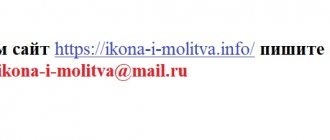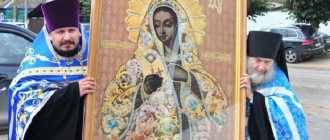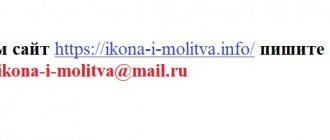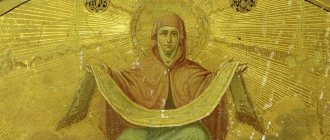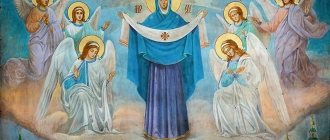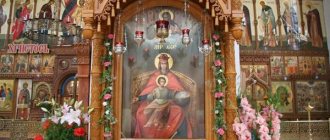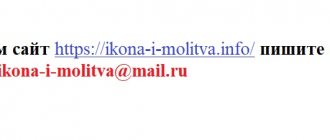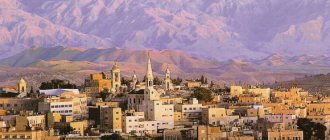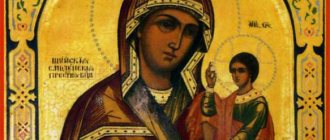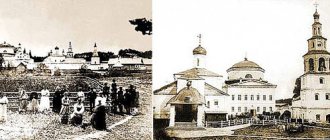Quadripartite icons are four different icons, each with its own subject, painted on one board. It is not known exactly when such icons appeared in Rus', but in Novgorod in the 15th century there were already icons of this type.
As a rule, such an icon is divided in the center by a crucifix depicting the face of Christ or His crucified figure. Most often, an icon with a crucifix depicts the deeds of saints, when each of the four icons depicts some moment of their life and deed.
One of the most famous is the four-part icon of the Mother of God called “Motherhood”. It depicts the Mother of God holding the Baby Jesus in her arms at different moments of His infancy and childhood. This is an icon of Byzantine writing; it is assumed that it was written in the 6th century, but in Rus' it was discovered only in the second half of the 17th century near Minsk. Legend has it that the icon was found on a tree. Later, at the site where the icon was found, a temple was erected in honor of the Dormition of the Blessed Virgin Mary.
Description of the four-part icon of the Mother of God
Even if compared with ordinary icons, the icon of the Mother of God is quite rare. If they start talking about four-part icons, they first of all remember the “Motherhood” icon. It looks like this.
In the lower left part there is the “Leaping of the Child” icon, depicting the Child Jesus playing with his Mother. She carefully holds him in her arms, and He presses his cheek to Her face and strokes it with his hand.
In the lower right part there is the “Education” icon, where Jesus is in the arms of the Mother, raising his hand, apparently saying something, and the Mother listens to him, bowing her head.
In the upper left part there is the “Mammal” icon. This is a chaste image of how the Mother of God feeds the Divine Child with her milk.
In the upper right part there is an icon “Helping Childbirth”, where the Mother of God holds in front of her, like a shield, a symbolic image of a child in the womb.
In the center is a crucifix with the face of Jesus Christ.
It is noteworthy that on the icon “Helping Childbirth” the Mother of God is depicted with her head uncovered, as befits a girl, while on all the other three icons her head is covered, as married women traditionally wore.
And you can’t help but notice how sad her face is. Usually mothers look at their little children with a smile, but this Mother knows what torment awaits her Son, and therefore her gaze is filled with sadness and submission to the Will of God.
Four-part icon in the Annunciation Cathedral
The unique four-part icon is located on the southern wall of the Annunciation Cathedral, next to the local iconostasis. It is a real theological treatise, revealing the content of liturgical texts using ancient Russian painting.
The icon is divided into four equal parts, each of which has its own name. They should be read from the top left counterclockwise. “And God rest on the seventh day” – upper left, “Come, let us worship the Tripartite Deity” – lower left, “In the carnal tomb” – lower right, “The Only Begotten Son and Word of God” – upper right. The upper left part illustrates the words: “And God rests on the seventh day,” that is, its iconography tells about the divine creation of the world.
The main idea of all parts of the icon is God's providence for humanity, starting from the creation of the world, to the creation of man, and, through the crucifixion of Christ, to the Resurrection.
Table of contents
Four-part icon. Iconography
The sky is depicted in the upper register; it is separated from the earth by a wavy line. In the central part of the sky, in spheres reminiscent of the spheres of the “Savior in Power” from the Deesis order, there is the Lord of Hosts, reclining on a bed in light robes, on the left is the Mother of God of the Sign, and above is the Holy Spirit.
In the upper left corner of the icon God the Father is depicted, with a cross in the background and the crucified Christ in the background. The Savior is depicted with wings, like a cherub.
On the right it is echoed by the image of Christ in a kind of almond-shaped halo. The father seems to bless his son for his earthly feat.
And in the lower case of the first part, the creation of Adam and Eve, the expulsion of Adam and Eve from paradise and the murder of Abel by Cain are written on earth.
The lower left part, in which three registers are also distinguished, illustrates the text “Come, let us worship the Tripartite Deity.”
The same division between heaven and earth is present here. The upper register depicts something happening in the sky.
In the middle part - between heaven and earth, we see the coming of the Savior into the world in the scenes of the Annunciation, Nativity and Baptism.
But in the lower part the three-part deity is worshiped “by those who are alive.” We see the faces of saints in prayer: prophets, apostles, martyrs, saints, righteous people. A young woman with a baby in her arms is also written here, and in front of her is a young man in a crown. These images clearly point to Ivan the Terrible and his young wife Anastasia Romanovna with his heir.
In the next part, the master wrote the end of the earthly life of the Savior and the beginning of divine salvation - this is a liturgical song: “In the grave the carnal ones, in hell with the soul like God, in paradise with the thief and with the Father on the throne.”
And indeed, “carnal in the grave”, “in hell with a soul like God” - in the lower register the scene of the “Descent into Hell” is depicted.
On average, the composition “In Paradise with the Thief” is clearly readable; this is the scene “Christ and the Prudent Thief”. In the same register there are people (the righteous) coming out of the cave.
The upper register of the third movement contains the composition “On the Throne”.
Four-part icon. Trinity Image
This image of the New Testament Trinity (“The Altar” - the Father and the Son are shown on the throne at the same time, and between them the Holy Spirit in the form of a dove) first appears in Russian iconography on this icon.
Previously, in Rus' only the Old Testament Trinity was depicted - three angels before Abraham. The New Testament Trinity, as an iconographic type, appears only during the reign of Ivan the Terrible. In general, this entire icon represents a new word in sacred painting. The last part, located at the top right, illustrates the liturgical hymn “The Only Begotten Son and Word of God.”
In the last part, just like in the first, heaven and earth are shown. In the center of the middle part, on the border of heaven and earth, behind the empty tomb, the deceased Christ is depicted, embraced by the Mother of God. The composition is called “Mourning of the Only Begotten Son”; such iconography has existed in Balkan sacred art since ancient times.
On the left and right, two architectural structures are shown in the upper register. They rise on the rocky peaks of the earth's zone. The structure on the right looks like some kind of antique building, to the left of it is an angel carrying the moon on his head. On the left is a temple, next to it is an angel with the sun. Both the moon and the sun have faces.
The ancient building and the angel with the face of the moon can be interpreted as an Old Testament synagogue; they are likened to the Old Testament. The white three-domed temple and the angel with the face of the sun personify the new church - heavenly and earthly and the New Testament. That is why the face of God Emmanuel in the red halo of “glory” is turned to the church, he points his hand towards it. The bottom images correspond to the top ones. Under the allegories of the Old Testament, on the right, in the black cave of the underworld, death reigns. It is painted in the form of a bony corpse with a scythe in his hand, riding an apocalyptic beast.
Under the church - a symbol of the New Testament - the victory of Christ over death and hell is shown. In the yawning abyss of hell on the left, Archangel Michael in a red cloak strikes with a spear the fallen “prince of darkness” - Satan (the personification of hell), whose demonic army retreats into the depths of the cave. Here the victory over death and hell and the triumph of the church are depicted: the Archangel defeats death, kills Satan and people emerge from the dark cave, from hell.
On the edge of this cave (above the Archangel) a man in armor sits, crossing his legs. In fact, he does not have a helmet on his head, but a cross-shaped halo. This is an image of Christ - the conqueror of death. This depiction of the Savior caused the greatest protest and indignation. But, nevertheless, the icon was approved.
Four-part icon. Iconography controversy
The appearance of this icon caused heated theological debate. Such images gave rise to denial among highly educated people. They discussed and condemned the very possibility of the appearance of such sacred subjects. Immediately after its writing, the clerk of the embassy order, that is, in modern terms, a major official of the Ministry of Foreign Affairs, Ivan Viskovaty wrote a request for the opportunity to discuss such an image at a church council. The church council met and, by the decision of Metropolitan Macarius, approved her iconography.
The “four-part” icon is a detailed theological “treatise on the trinity of the deity” and, at the same time, a brief summary of the main events of the Old and New Testaments, including the Apocalypse, revealed in the language of fine art. The main representatives of the heavenly and earthly hierarchy are depicted here. In different iconography, the Trinity is represented in each part of the icon.
Most likely, Metropolitan Macarius himself participated in the development of the plots of the four-part icon. It was created by Pskov craftsmen in the middle of the 16th century. This icon was one of those that appeared in the Annunciation Cathedral after the fire of 1547. Such an image could only be understood by a few “sophisticated” theologians. Therefore, the icon of the Annunciation Cathedral remained a unique creation of its time. Few lists were made only from individual fragments of this icon.
Moscow's political horizon; at the council of 1667 - on the issue of some images that were rightly rejected by Viskovaty; finally, in the 19th and 20th centuries he was rehabilitated and essentially the basic principles of his iconographic reasoning.”
Quote and photos from the Orthodox forum. The article was written based on materials from the Kremlin lecture hall and the article “Four-Part Icon”.
Next: Double-decker bus in Moscow
Related articles: Icon “Alexander Svirsky in the Life” in the Assumption Cathedral of the Moscow Kremlin Virgin Mary image in the Kremlin Adoration of the Magi
Off-topic articles: Guide in Moscow Excursions around Moscow and the Moscow region Walking tours around Moscow Excursion around Red Square and Alexander Garden Excursion to the Novodevichy Convent Excursion to the palace of Alexei Mikhailovich Private guide-translator in Moscow
The meaning of the four-part icon of the Mother of God with the crucifix
One can rightfully say that the four-part icon of the Mother of God is an icon primarily for women, because it depicts the most important thing in the life of every woman - motherhood, and it is not for nothing that the icon received such a name.
The icon protects mother and child even before it is born
While the child is in the mother’s womb, the icon protects them both from adversity, and then, when the due date comes, it helps the mother in labor during a difficult birth.
“Motherhood”, a four-part icon with a crucifix, the meaning of which is clear without words, should be in the home of every woman. It is often given to girls getting married or women expecting a child, especially their first child. But regardless of whether a woman has children or not, such an icon will become a talisman and protection for her - protection from everything that could harm her family and children.
It doesn’t matter in what style it is written, this list in any case corresponds to the Orthodox church canons. Before her they pray for the health of children and relatives, and the prayer “Living Help” helps pregnant women bear a child without complications. It is best to give a four-part icon of the Mother of God on the Nativity of the Virgin Mary and on the Dormition of the Virgin Mary, or on the date of celebration of the icon - January 25. On this day you need to pray for the health of your children and parents.
Icon of the Mother of God "Motherhood"
A four-part icon consisting of images of the Most Holy Theotokos (from left to right, top to bottom): “Mammal Nurse”, “Helping Childbirth”, “Baby Leaping”, “Educator”.
Icon of the Mother of God, called the “Mammal”
This ancient icon is one of the best examples of the Byzantine school and has a rich history. It is associated with the name of Saint Sava the Sanctified - the founder of the monastery, once located 18 miles from Jerusalem. Saint Sava departed to the Lord in 532, prophetically bequeathing the icon to a noble pilgrim from Serbia also named Sava. Six centuries later, the monks waited for another Saint Sava - the Archbishop of Serbia. He transferred the “Mammal” to the Hilendar monastery on Mount Athos, to the founding of which he was directly related. In Russia, the “Mammal” is a very rare icon, although in 1860 a copy of it from Mount Athos was sent to the Kursk province and soon acquired miraculous power. The discovery of another Russian “Mammal” took place in 1650 - it was discovered on a tall tree twenty miles from the city of Minsk. It was on this site that the temple was built in honor of the Dormition of the Blessed Virgin Mary. There are many legends about the miraculous power of this icon; it helped in getting rid of various troubles and illnesses, and saved people during the Swedish invasion. The icon is rare and not very common in lists.
Celebration: 25
(12)
January.
Miraculous Icon of the Mother of God “Helping Childbirth”
“Helping Childbirth” (or “Helper in Childbirth”) is the name of a miraculous icon revered in Orthodox Russia. It is unknown when this icon was painted, but since ancient times people have known that there is no better help during difficult childbirth than the help of this miraculous icon. Many miracles are attributed to the “Helping Childbirth” icon. It is believed that the icon helps infertile women, healing them from illness, and helps the birth of a child during a difficult pregnancy. There are many known cases when, after a sincere prayer of a pregnant woman in front of a holy image, the fetus, lying “wrongly” in the womb, turned head down just before the birth and the birth was successful.
Celebration: January 8
(December 26)
Icon of the Mother of God “Leaping Baby”
The Icon of the Mother of God “Leaping of the Child” appeared on November 7, 1795, eighteen versts from Moscow and six and a half versts from the Lyubertsy station of the Moscow-Kazan railway, near the village of Gremyacheva, in the ancient Nikolo-Ugreshsky monastery, founded by Dimitri Donskoy in honor of the victory at Kulikovo field in 1380. The history of the creation of the monastery is connected with the name of the holy noble prince Demetrius Donskoy. During the battle of the holy prince against Kulikovo, 15 versts from Moscow, in the branches of trees, an icon of St. Nicholas the Wonderworker unexpectedly appeared to him. Seeing an image appear out of nowhere, the prince took it as a sign of God’s special blessing and joyfully exclaimed: “This whole sin (warmed) my heart!” - and made a vow in case of victory to create a monastery on this site.
This is how the Ugreshsky monastery appeared on the map of Russia with a cathedral church in honor of St. Nicholas, also nicknamed Nikolo-Ugreshsky, in which the miraculous icon of the Mother of God subsequently appeared, called “Leaping”.
For many years, the icon was one of the symbols of the Nikolo-Ugreshsky monastery (now the city of Dzerzhinsky, Moscow region).
After the revolution, during the destruction of the monastery, the icon disappeared. A list of the miraculous icon from 1814 has survived to this day. Currently, this ancient image is part of the collection of the Moscow State United Museum-Reserve. In the 90s of the 20th century, several copies were made from it, one of which was transferred to the Nikolo-Ugreshsky Monastery and is now in the monastery museum-sacristy.
In the monastery there is another revered image of the “Leaping” icon of the Mother of God.
According to the website of the Nikolo-Ugreshsky monastery https://ugresha.org: “At the beginning of the 21st century, in the Nikolo-Ugreshsky monastery there was a miraculous discovery of another image of the Mother of God “Leaping”. In a providential manner, a group of believers, who wished to remain anonymous, transferred to our monastery a copy of the icon of the Most Pure Virgin, which, although stylistically different from the revealed Ugresh image, belongs to the same iconographic type. With the procession of the cross, the brethren of the monastery and its parishioners solemnly greeted the icon “Leaping of the Child” at the Holy Gates. The image was brought to the Transfiguration Cathedral, where it is kept to this day, rightfully being one of the most revered in the monastery.”
The Ugresh image “Leaping” differs from the most common variants of this image called “Leaping of the Child”. In most compositions of this icon, the Baby Jesus, sitting on the left or right hand of the Mother of God, is depicted as if playing and impulsively reaches out with his hands to the face of His Mother, touching Her chin or cheek, sharply throwing his head back.
Icons with the name “Leaping of the Child” are common in the Balkans and Mount Athos. In Russia, on the day of the celebration of the Ugresh image, the feast of all icons of the Mother of God “Leaping” is traditionally celebrated. “Leaping” is a Russian icon of ancient writing, painted from a Greek model. In the Byzantine Empire, this image was revered as an ancient miraculous shrine. Icons of the Mother of God of the same name are found in the Moscow Novodevichy Convent and in the Vatopedi monastery on Mount Athos.
Celebration: 20
(7)
November.
Icon of the Blessed Virgin Mary, called “Education”
This icon is a copy of an ancient Byzantine icon. The Mother of God is depicted with the Eternal Child sitting on Her left hand. The right hand of Christ is stretched upward to the face of the Most Pure Virgin. Until 1917, the holy image was placed in the Kazan Cathedral on Red Square, but after its destruction it was lost; now there is a copy of the miraculous icon, famous throughout Russia for its miracles. The name of the icon speaks for itself. In front of her, parents pray for their children, asking the Most Holy Theotokos to take them under Her protection, send them reason and fill their hearts with wisdom. Also, a short prayer to this image has survived to this day: “I entrust my child entirely to my Lord Jesus Christ and to Your, Most Pure One, heavenly protection.”
Celebration: 18
(5)
Martha.
